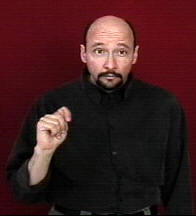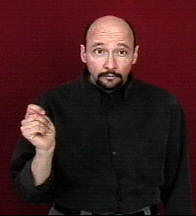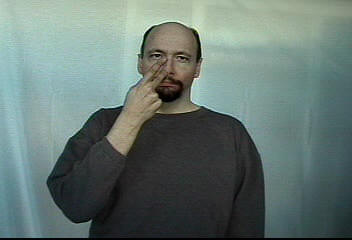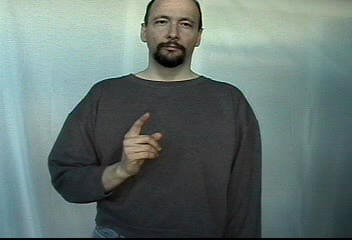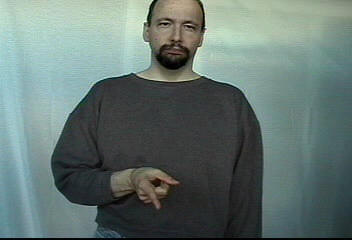American Sign Language: "urinate"
/ "pee"
POTTY = BATHROOM
A frequent question in households with children and/or developmentally disabled folks is:
"Do you need to go potty?"
Above I'm asking, "Do you need to go to the bathroom?"
The forward tilt of the head and raised eyebrows indicate that it is question to which there is expected a "yes" or "no" response. The sign for "bathroom" is made by forming the right hand into the letter "t." The palm side is facing away from you. Shake your hand side to side a couple times. Some people use a twisting movement instead of the side to side shake. Either is fine.
URINE / pee (general)
If you are in interpreter interpreting for a Deaf student in a classroom of juveniles you might want to simply fingerspell "U-R-I-N-E" or "P-E-E" and observe your client's face to make sure he or she understands. However if for whatever reason you specifically need to indicate "urine, pee, or peeing" you have several choices.
The general sign for "pee" is done by touching the letter "P" to your nose while puffing out your cheeks a bit.
Note: it is the tip of the middle finger that touches the tip of the nose.
Note: If you don't puff out this sign, and you use a double movement this sign means "p_nis." (The male bodypart).
Context also helps to make it clear what you mean. If someone signs, "MY [P-hand on nose] HURT" -- you can assume that either his organ is hurting him (or perhaps the process of peeing is painful). If that person signs "I NEED P-hand on nose]" -- it would be fairly safe to assume they mean that they need to urinate.
PEE (puffed cheeks, single movement)
URINATE / peeing / take a leak
Okay, so, this version is specifically for "guys." It is used to specifically describe the act of a male taking a wiz. I thought about not including it here (since I strive to build a "kid friendly" site) but since many interpreters, social workers, and/or group home workers need to know signs like this I figured I'd better include it here. Take an index finger and hold it a bit upright then point it down and forward as you puff out your cheeks.
Animation: URINATE (".wmv" format)
Discussion:
In a message dated 6/29/2011 10:08:29 P.M. Pacific Daylight Time, a nurse named "Mary" writes:
As a nurse with just one semester of ASL under my belt (which didn't include signs for bodily fluids), I need to know what sign I should use for "urine." I tried the double tap on the nose with a "P" with my cheeks puffed out, as your website suggests, and that earned snickering from the poor patient I needed a urine sample from. Most sources I've checked show the same sign for "urine" and "penis" (double tap without cheeks puffed out). Obviously, I want to be clear about which I mean. The snickering (when I had my cheeks puffed out) makes me wonder if there is another sign I should be using. Or should I just fingerspell to be clear? Other people I asked have told me to use the shaken "T" for toilet sign, but is that specific enough to urine? It doesn't seem like it would be very confusing, especially if I'm explaining how to do a clean-catch urine sample, which requires that a patient pees a little first in the toilet before peeing in the specimen cup. If I'm just using a shaken T throughout that, how would the patient know I'm trying to differentiate between urine and the actual toilet?
Thank you for your help.
Mary
Dear Mary,
Hello :)
Thank you for striving to do a good job in a very challenging profession. I appreciate folks like you making an effort to learn American Sign Language.
Regarding the "P-hand on the nose" sign -- if you use a double tap, it causes the sign to take on more of a "noun" aspect and thus puts it in the realm of "p_nis" rather than "pee." Yes, of course "urine" is a noun too, but in everyday life "peeing" is something you "do" not something you have. Your challenge is that you actually want to "have" some pee. Regardless, for sign for URINE I'd recommend you not do the double tap.
If you are dealing with an adult or someone who knows the word "urine" I recommend you sign something to the effect of:"YOU NEED GO BATHROOM U-R-I-N-E" (Then hold up the cup.)
If you are dealing with someone who doesn't know what "urine" means then you could spell "P-E-E." Or if you are dealing with a young child or developmentally disabled adult you might want to try the "PEE" sign.
The concept of getting a "clean catch" urine sample can easily be expressed by a skilled signer but it is downright challenging for a beginner. The exact signs will also vary depending on whether you are describing the process for a female or a male.
It would go something like this:
Instructions to a male, assuming you are a right handed signer:
YOU NEED GO BATHROOM. BOWL-(toilet) START left-hand=CL:C-"bowl" right-hand=CL:Index-finger-"peeing." HOLD! (facial expression = intensity). rh-(change into an "X" hand, palm facing left) Left-hand C-U-P CL:C-(modified classifier:C "small cup" = two fingers and thumb, move the cup into the path of the soon to be resumed stream). rh-(change from an "X" hand back into an "Index finger" to indicate that the flow has resumed).
Now, I realize trying to figure all that out from the text is probably like trying to understand "music" by reading about it. So I'll see what I can do about video recording that for you and posting it to the "urinate" page.Cordially,
Dr. Bill
You can learn American Sign Language (ASL) online at American Sign Language University ™
ASL resources by Lifeprint.com © Dr. William Vicars
Want to help support
ASL University? It's easy:
DONATE (Thanks!)
(You don't need a PayPal account. Just look for the credit card
logos and click continue.)
Another way to help is to buy something from the ASLU "Bookstore."
Want even more ASL resources? Visit the "ASL Training Center!" (Subscription
Extension of ASLU)
CHECK IT OUT >
Bandwidth slow? Check out "ASLUniversity.com" (a
free mirror of
Lifeprint.com less traffic, fast access)
VISIT >
